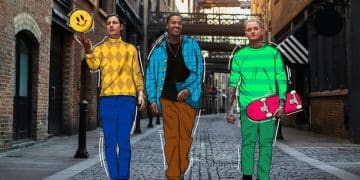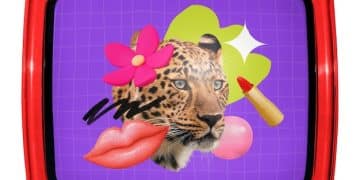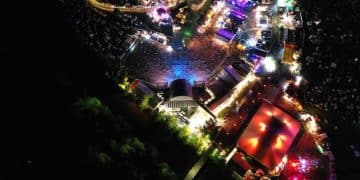Pop Culture’s Nostalgia Trip: Why the 90s Revival Is Here to Stay

Pop Culture’s Obsession with Nostalgia: Why the 90s Are Making a Comeback explores the resurgence of 1990s trends in fashion, music, and entertainment, driven by a longing for simpler times and a desire to reconnect with formative cultural experiences.
The Pop Culture’s Obsession with Nostalgia: Why the 90s Are Making a Comeback is undeniable. From fashion runways to streaming queues, the hallmarks of the decade are experiencing a major renaissance. But why is pop culture so fixated on the past and what does this mean for the future of creativity?
The Nostalgia Cycle: Why We Long for Yesteryear
Nostalgia is a powerful force, deeply embedded in the human psyche. It’s more than just remembering the past; it’s about imbuing past experiences with a sense of warmth, comfort, and belonging. Understanding the nostalgia cycle helps in understanding the cyclical nature of trends.
The Psychology of Nostalgia
Nostalgia is often triggered by feelings of uncertainty or anxiety about the present and future. By revisiting the past, individuals can tap into a sense of stability and security. This can be especially appealing during times of rapid change or social upheaval.
Cultural and Generational Factors
Each generation experiences nostalgia differently, shaped by the unique cultural landscape of their formative years. For millennials, the 1990s represent a pre-internet era, a time of relative simplicity and genuine connection. This perception fuels their desire to recreate and relive these experiences.
- The rise of social media platforms has amplified the nostalgia cycle, making it easier to share and consume retro content.
- Economic factors also play a role, as nostalgia can be a form of escapism from current economic challenges.
- Political and social events can trigger nostalgia as people seek comfort in familiar cultural touchstones.
In essence, the nostalgia cycle is a complex interplay of psychological, cultural, and economic factors that drive the recurrent fascination with past eras. It highlights our inherent human desire for comfort, connection, and a sense of continuity.
90s Fashion: From Grunge to Glam

The 1990s were a melting pot of diverse fashion trends, ranging from the rebellious grunge aesthetic to the polished glamour of supermodels. These iconic styles are experiencing a major comeback, influencing contemporary wardrobes and runway designs.
Grunge’s Enduring Appeal
Grunge, characterized by ripped jeans, oversized flannels, and combat boots, emerged as an anti-establishment statement. Its effortless cool and rejection of mainstream fashion ideals continue to resonate with individuals seeking authenticity and individuality.
The Return of Minimalism and Slip Dresses
Alongside grunge, the 90s also embraced minimalism, with slip dresses, tailored suits, and clean lines dominating the fashion scene. This understated elegance offers a timeless appeal and provides a versatile canvas for modern interpretations.
- Chokers and platform shoes, quintessential 90s accessories, have made a strong comeback, adding a retro touch to modern outfits.
- The popularity of vintage and thrift shopping has further fueled the resurgence of 90s fashion, offering unique and affordable pieces.
- Designers are drawing inspiration from 90s silhouettes and fabrics, incorporating retro elements into contemporary collections.
From the gritty realism of grunge to the refined simplicity of minimalism, 90s fashion offers a diverse range of styles that continue to inspire and influence the fashion industry today. The revival of these trends reflects a desire for authenticity, comfort, and a touch of rebellious spirit.
Music of the 90s: The Sound of a Generation
The 1990s was a golden era for music, producing a diverse range of genres that defined a generation. From grunge and alternative rock to hip-hop and electronic dance music, the sounds of the 90s continue to resonate with listeners of all ages.
Grunge and Alternative Rock
Bands like Nirvana, Pearl Jam, and Soundgarden dominated the airwaves with their raw energy and angsty lyrics. Grunge’s influence extended beyond music, shaping fashion, art, and cultural attitudes.
The Rise of Hip-Hop and R&B
The 90s saw the emergence of iconic hip-hop and R&B artists like The Notorious B.I.G., Tupac Shakur, and TLC. These artists pushed creative boundaries, addressing social issues and reflecting the experiences of marginalized communities.

The music of the 90s was a powerful force that shaped identity, fostered community, and reflected the social and political landscape of the decade. Its enduring appeal lies in its authenticity, diversity, and ability to evoke strong emotions and memories.
90s TV and Film: From Sitcoms to Blockbusters
90s television and film played a significant role in shaping pop culture, introducing iconic characters, memorable storylines, and groundbreaking visual techniques. The decade produced a wealth of content that continues to entertain and inspire audiences today.
The Golden Age of Sitcoms
Shows like “Friends,” “Seinfeld,” and “Frasier” captivated audiences with their witty humor, relatable characters, and ensemble cast dynamics. These sitcoms offered a comforting escape from reality and became cultural touchstones for a generation.
Blockbuster Films and Independent Gems
The 90s also saw the rise of blockbuster franchises like “Jurassic Park” and “Titanic,” which pushed the boundaries of visual effects and storytelling. Alongside these big-budget productions, independent films like “Pulp Fiction” and “Good Will Hunting” gained critical acclaim and influenced the direction of cinema.
- The popularity of streaming services has made 90s TV shows and films readily accessible to new audiences, fueling their resurgence.
- Remakes and reboots of classic 90s properties are capitalizing on nostalgia and introducing these stories to a new generation.
- The themes and issues explored in 90s TV and film, such as identity, relationships, and social change, remain relevant today.
From the comforting familiarity of sitcoms to the groundbreaking innovation of blockbuster films, 90s TV and film left an indelible mark on pop culture. The revival of these properties reflects a desire for connection, entertainment, and a sense of shared cultural history.
Gaming in the 90s: The Dawn of Digital Entertainment
The 1990s was a pivotal decade for gaming, witnessing the rise of console wars, the introduction of groundbreaking genres, and the dawn of online multiplayer experiences. These innovations laid the foundation for the modern gaming industry.
The Console Wars and Defining Titles
The rivalry between Sega and Nintendo fueled innovation and produced iconic consoles like the Sega Genesis and the Super Nintendo. Games like “Sonic the Hedgehog” and “Super Mario World” became cultural phenomena, defining the gaming landscape for years to come.
The Emergence of PC Gaming and Online Multiplayer
The 90s also saw the rise of PC gaming, with titles like “Doom” and “Quake” revolutionizing the first-person shooter genre. The introduction of online multiplayer capabilities transformed gaming into a social experience, connecting players from around the world.
Gaming in the 90s was a transformative force, shaping entertainment, technology, and social interaction. The nostalgia for 90s gaming reflects a desire for simpler times, challenging gameplay, and the communal experience of playing with friends and family.
The Enduring Appeal of 90s Nostalgia in the 2020s
The enduring appeal of 90s nostalgia in the 2020s stems from a desire to reconnect with a perceived simpler time, a longing for familiar cultural touchstones, and a yearning for authentic experiences in an increasingly digital world.
The Search for Authenticity
In an era of curated online personas and fleeting trends, the 90s represent a time of greater authenticity and genuine self-expression. The raw energy of grunge, the unfiltered humor of sitcoms, and the unpolished graphics of early video games offer a refreshing contrast to the hyper-produced content of today.
The Power of Shared Experiences
Nostalgia fosters a sense of community, connecting individuals through shared memories and cultural references. Revisiting 90s pop culture allows people to relive formative experiences, bond over common interests, and create new memories together.
- The nostalgia cycle is likely to continue, with each generation eventually looking back fondly on their own formative years.
- The key to successful nostalgia-driven content is authenticity and a genuine respect for the source material.
- Nostalgia can be a powerful tool for creativity, inspiring new works of art, music, and entertainment that build upon the foundations of the past.
Ultimately, the enduring appeal of 90s nostalgia lies in its ability to evoke positive emotions, foster connection, and provide a sense of continuity in a rapidly changing world. It reminds us of where we came from and inspires us to create a better future.
| Key Concept | Brief Description |
|---|---|
| 📼 90s Music | Grunge, hip-hop, and electronic music defined the decade’s sound. |
| 👕 90s Fashion | Grunge, minimalism, and iconic accessories like chokers resurface. |
| 📺 90s TV/Film | Sitcoms and blockbusters shaped pop culture and are revived today. |
| 🎮 90s Gaming | Console wars and the dawn of online gaming fueled digital entertainment. |
Frequently Asked Questions
▼
The popularity of 90s nostalgia stems from a desire to reconnect with a perceived simpler time, offering comfort and familiarity in an era of rapid change and digital overload. It’s also fueled by shared experiences and cultural touchstones.
▼
Several fashion trends from the 90s have made a comeback, including grunge-inspired outfits, minimalist slip dresses, chokers, and platform shoes. These styles offer a blend of comfort, individuality, and retro flair.
▼
90s music genres like grunge, hip-hop, and R&B continue to influence contemporary artists and music styles. The raw emotionality and social commentary found in 90s music still resonates with listeners today.
▼
90s TV shows and movies offer a sense of nostalgia, comfort, and escapism. They often feature relatable characters, humorous storylines, and exploration of social issues that remain relevant in modern society.
▼
90s gaming introduced iconic consoles, groundbreaking genres, and the dawn of online multiplayer, laying the foundation for the modern gaming industry. Games from this era continue to be celebrated and remade for new audiences.
Conclusion
The resurgence of 90s pop culture reflects a deeper human need for comfort, connection, and authenticity in an ever-changing world. As we navigate the challenges of the present, revisiting the past can offer valuable insights and inspire us to create a brighter future.





